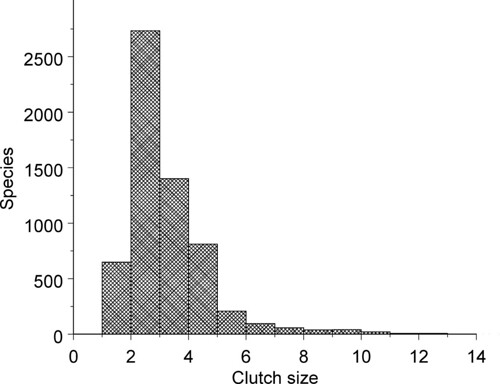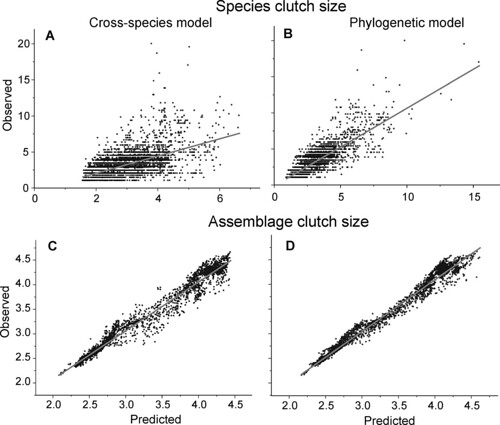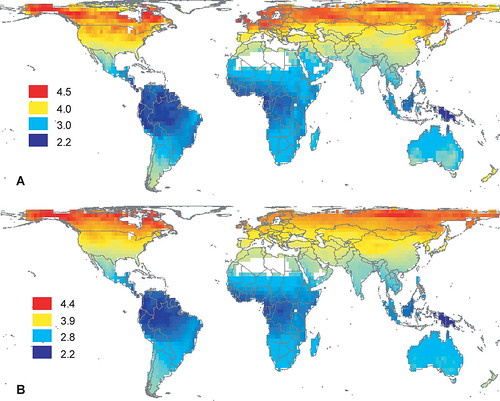tags: evolution, avian clutch size, ornithology, birds, avian
The Little Tinamou, Crypturellus soui,
usually lays two eggs in a small depression on the forest floor.
Anyone who has ever watched birds closely or who has bred them in captivity knows that different species of birds have different clutch sizes, with some species laying only one egg while others produce as many as ten eggs per clutch or more. Why is there such a tremendous difference in clutch size? What evolutionary factors affect the average clutch size that each species produces? Do closely related species have similarly sized clutches? Is it possible to predict the clutch size for a particular species? An international research team wondered these same things and decided to taker a closer look at the phenomenon of clutch size in birds.
"In this study, we answer one of the most basic questions asked about birds: Why do bird species lay different numbers of eggs?" reports one of the study's authors, Cagan Sekercioglu, a senior research scientist at Stanford University. "The integration of geographic and life history datasets enabled us to simultaneously address the importance of ecological, evolutionary, behavioral and environmental variables in shaping the clutch size of world's birds."
To do this research, the team, headed by Walter Jetz, an associate professor of biology at UC San Diego, used the most comprehensive dataset on clutch size ever compiled, comprising 56% of all known landbird species, and they combined it with data on the basic biology, natural history and typical environment for each of them.
First, they documented the average clutch size for 5,290 species and found that, despite tremendous variations, more than half of all bird species analyzed lay either 2 or 3 eggs (figure 1);
Figure 1. Global Variation in Species Clutch Size
Shown are mean clutch sizes of all 5,290 species of landbirds in the analysis
(six species with clutch sizes > 14 not illustrated). [larger view].
DOI: 10.1371/journal.pbio.0060303
The "tail" on the right side of this graph is due to the heavy influence of northern temperate-zone species: despite there being fewer of them overall, they are much better studied than are tropical and southern temperate-zone species, so their influence is over-represented in these data.
But when the team looked closely at birds on a global scale, they found three strong biological determinants of clutch size in birds: first, migratory birds whose chicks require intense parental care (otherwise known as "altricial": which means "requiring nourishment") produce larger clutches than altricial nonmigrants. A second strong biological determinant of clutch size is nest type: cavity nesters, which are naturally exposed to lower rates of nest predation, tend to have larger clutch sizes than open nesters, and species with half-open nests are in between the two. Third, clutch size varies by diet, with granivores and omnivores laying larger clutches than frugivores and nectarivores (figure 2);
Figure 2. Partial Residual Plots for the Combined Intrinsic-Extrinsic Model of Clutch Size
This plot (also called component + residual plot, response: Comp+Res) illustrates the relationship between a predictor and the response given other predictors in the model (specifically, it is a plot of ri + bxi versus xi, where ri is the ordinary residual for the i-th observation, xi is the i-th observation and b is the regression coefficient estimate). For Mass, the solid line and solid symbols refer to altricial species, the dashed line and open symbols to precocial species. To visualize the interaction with Precocial, we excluded that variable for the two interacting predictors (Mass, Migrant) in the calculation of ri. Abbreviations in Diet: Vert, vertebrates; Invert, invertebrates; Mixed, omnivore; PlaSee, plants and seeds; FruNect, fruits and nectar. In Realm: NeA, Nearctic; NeT, Neotropics; PaA, Palearctic; AfT, Afrotropics; InM, IndoMalaya; Aus, Australasia; Ocn, Oceania. In Migrant: Non-mig, non-migrant. For further details, see Table 1 (cross-species model Both). [larger view].
DOI: 10.1371/journal.pbio.0060303
As you can see in the above figure, the team also considered environmental effects upon clutch size, effects such as latitude. Their data corroborated the latitude effect hypothesis, but the team when further and asked what about latitude affects clutch size. They found that seasonal difference between summer and winter temperatures was the strongest environmental predictor: clutch sizes are smallest in species inhabiting relatively aseasonal environments and increase linearly with temperature seasonality
The team tested each model to determine how well the data fit each model. The found that either the pure biological (intrinsic) or the pure environmental (extrinsic) model accounts for a substantial amount of cross-species variation in clutch size (32% and 27%, respectively). But their combined biological-environmental model explains 44% and also predicts the absolute variation in clutch size (Figure 3);
Figure 3. Cross-Species and Cross-Assemblage Model Fits
Fit between the observed clutch size and that predicted by the combined intrinsic/extrinsic multi-predictor model (Both, Table 1) across 5,290 species (A and B) and 2,521 grid cell assemblages of 220 Ã 220-km size [(C and D) for geometric mean of assemblage clutch size]. Fits were evaluated for the cross-species model (A and C) and the nested phylogenetic model (B and D). Least squares fits are shown. For details, see text and Table 1. The spatial patterns of the assemblage predictions are illustrated in Figure 4. [larger view].
DOI: 10.1371/journal.pbio.0060303
When the observed clutch sizes were color-coded and documented on a map of the world, the team found the average clutch sizes across assemblages show a remarkably strong geographic gradient from an average of 4.5 eggs at the high northern latitudes to just over two eggs in the tropics (figure 4a). Further, the predictions made by the global eco-geographic model (figure 4b) shows an exceptionally close match to actual observed data (figure 4a).
Figure 4. Geographic Variation in Assemblage Clutch Sizes, Observed and Predicted
Shown are observed (A) and predicted (B) geographic patterns of the geometric mean clutch size across 5,290 bird species in 2,521 grid cell assemblages of 220 Ã 220-m size for the cross-species model. Only assemblages with >30 species illustrated. For other details, see Figure 3. [larger view].
DOI: 10.1371/journal.pbio.0060303
This research confirms previously proposed hypotheses regarding clutch size: species that are short-lived or have a low survival rate among their offspring tend to lay more eggs at one time to increase the chances of having surviving offspring. In contrast, longer-lived species or those with a higher survival rate among offspring tend to lay fewer eggs in their nests and invest more time and effort in raising their offspring.
This study further demonstrates how life-history traits are jointly determined by the complex interplay of intrinsic biological traits, phylogenetic affinities, and the environment of a species.
"Our results demonstrate not only where bird species live, but how the way they live their lives, specifically their reproduction strategies, has evolved in close association with climate, particularly seasonality," said Jetz.
But what importance does this research have, beyond being additional evidence for the power of evolution? This study provides additional evidence that some species are more sensive than others to becoming endangered or extinct in response to environmental disturbances.
"Rapid changes to the global geography of climate are likely to impact both aspects and to potentially perturb the long-evolved link between the 'where' of life and the 'way' of life in many species," Jetz points out.
Understanding biological and environmental interactions is vital for predicting consequences of future climate change and the potential impacts on avian biodiversity, particularly since it will have stronger affect birds in particular geographic regions more strongly than those in other regions.
"The majority of bird species live in the tropics. Tropical birds' smaller clutch size is greatly shaped by more stable climates and these birds' survival depends on the continuity of the weather conditions they have adapted to during millennia," Sekercioglu added. "Climate change and a potential increase in climatic fluctuations in the tropics may make these birds highly vulnerable. Hundreds of tropical bird species are already threatened with extinction and a potential clash between changing climate and their reproductive strategies may cause additional harm."
Source:
Walter Jetz, Cagan H. Sekercioglu, Katrin Böhning-Gaese (2008). The Worldwide Variation in Avian Clutch Size across Species and Space PLoS Biology, 6 (12) DOI: 10.1371/journal.pbio.0060303.
- Log in to post comments






I wonder if George Orwell was aware of this.